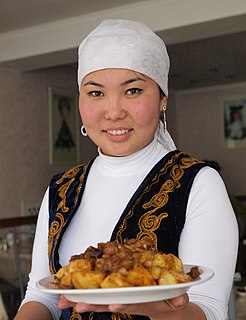 W
WThe culture of Kyrgyzstan has a wide mix of ethnic groups and cultures, with the Kyrgyz being the majority group. It is generally considered that there are 40 Kyrgyz clans, symbolized by the 40-rayed yellow sun in the center of the flag. The lines inside the sun are said to represent a yurt. The dominant religion of Kyrgyzstan is Sunni Islam (91%). The Russian population is Russian Orthodox.
 W
WAitysh Public Fund is a charitable organization, which aims to promote and develop culture throughout Kyrgyzstan. Founded by public figure, producer and director Sadyk Sher-Niyaz in 2001 in the capital of Bishkek, the structure of the Fund consists of the Union of Improvised Singing ‘Aitysh’, Film Production Company ‘Aitysh Film’, International Film Festival "Kyrgyzstan - Land of Short Films", Manas Cinema network and Literary Organization ‘Kalemger’.
 W
WAqsaqal or aksakal metaphorically refers to the male elders, the old and wise of the community in parts of Central Asia, the Caucasus and Bashkortostan. Traditionally, an aqsaqal was the leader of a village or aul until the Soviet times. Acting as advisors or judges, these elders have or had a role in politics and the justice system in countries and tribes. For instance, there are aksakals courts in Kyrgyzstan. In Uzbekistan, which has traditionally been a more urban society, cities are divided up into mahallas. Each mahalla has an aqsaqal who acts as the district leader.
 W
WChapan (چاپان) or (چپان) is a coat worn over clothes, usually during the cold winter months. Usually worn by men, these coats are adorned with intricate threading and come in a variety of colors and patterns. It is worn in Central Asia, including Uzbekistan, Afghanistan, Tajikistan, Kazakhstan and Kyrgyzstan. A chapan cape was often worn by former Afghan president Hamid Karzai.
 W
WKyrgyz cuisine is the cuisine of the Kyrgyz, who comprise a majority of the population of Kyrgyzstan. The cuisine is similar in many aspects to that of their neighbors.
 W
WThe Day of the People's April Revolution is a national holiday in Kyrgyzstan that commemorates the Kyrgyz Revolution of 2010. Kyrgyz President Almazbek Atambaev signed a presidential decree authorizing the public holiday on April 4, 2016. On April 7, 2010, protesters led by opposition leaders stormed the parliament building in Bishkek and took over the headquarters of several major broadcasters. Roza Otunbayeva was then chosen as head of the Interim Government.The anniversary of the Revolution was declared a public holiday in 2011. and became a non-working holiday in 2016.
 W
WHunting with eagles is a traditional form of falconry found throughout the Eurasian Steppe, practised by ancient Khitan and Turkic peoples. Today it is practised by Kazakhs and the Kyrgyz in contemporary Kazakhstan and Kyrgyzstan, as well as diasporas in Bayan-Ölgii Provinces Bayan-Ölgii, Mongolia, and Xinjiang, China. Though these people are most famous for hunting with golden eagles, they have been known to train northern goshawks, peregrine falcons, saker falcons, and more.
 W
WKimeshek or Elechek is a traditional headgear of married women with children in Kazakhstan, Karakalpakstan and Kyrgyzstan. Kimeshek is also worn by Central Asian Jewish women. Uzbek and Tajik women wear a similar headdress called lachak. Kimeshek is made of white cloth, and the edge is full of patterns. Kimeshek might have different designs and colors based on the wearer's social status, age, and family.
 W
WState awards of the Kyrgyz Republic include the orders, decorations, and medals in Kyrgyzstan. They consist of military and civil decorations that are bestowed by various agencies of the government.
 W
WA shyrdak or syrmak is a stitched, and often colourful felt floor-covering, usually handmade in Central Asia. Kazakhs and Kyrgyz alike traditionally make shyrdaks, but especially in Kyrgyzstan, the tradition is still alive, and many of the products are sold to tourists.
 W
WA tubeteika is a Russian word for many varieties of traditional Central Asian caps. Tubeteikas are today worn in Tajikistan, Kazakhstan, Kyrgyzstan, and Uzbekistan, as well as in Muslim-populated regions of Russia and Azerbaijan. The skullcap worn by Uzbeks and Uyghurs is called a doppa and has a square base. It was a popular headgear among children throughout the USSR during the 1940s and 1950s.
 W
WTush kyiz are large, elaborately embroidered wall hangings, traditionally made in Kyrgyzstan and Kazakhstan by women to commemorate the marriage of a son or daughter. Colors and designs are chosen to symbolize Kyrgyz traditions and rural life. Flowers, plants, animals, stylized horns, national designs and emblems of Kyrgyz life are often found in these ornate and colorful embroideries. Designs are sometimes dated and signed by the artist upon completion of the work, which may take years to finish. The tush kyiz is hung in the yurt over the marriage bed of the couple, and symbolize their pride in their Kyrgyz tradition.